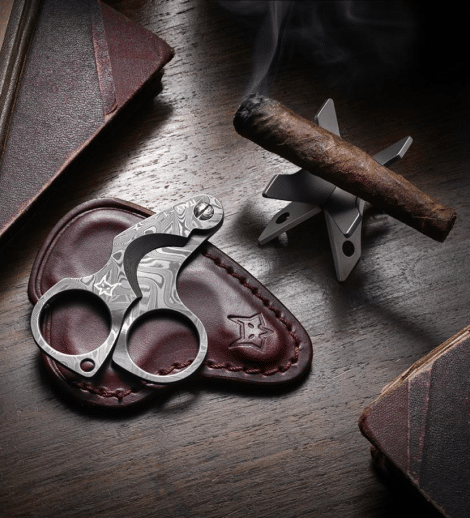
The best cut for a Cuban cigar, like any premium cigar, largely depends on personal preference. However, many cigar aficionados prefer the straight cut for Cuban cigars. A straight cut provides a clean and even opening, allowing you to experience the full range of flavors and aromas that Cuban cigars are known for. It’s essential to use a sharp and high-quality cutter to ensure a precise cut and avoid damaging the cigar wrapper. Ultimately, the “best” cut is the one that provides a smooth draw and enhances your enjoyment of the cigar.
The best tool for cutting a Cuban cigar is a high-quality cigar cutter, with the straight cut being a popular choice among enthusiasts. This type of cutter provides a clean and even opening, enhancing the smoking experience by allowing you to fully savor the cigar’s flavors and aromas. It’s essential to use a sharp and well-maintained guillotine or scissor cutter to ensure a precise straight cut, ensuring you get the most out of your Cuban cigar. Ultimately, the tool you find most comfortable and effective for your preferred cut is the best choice for you.
Properly positioning a Cuban cigar for cutting involves several essential steps. Firstly, carefully inspect the cigar, identifying the cap and the seam where it meets the wrapper. Hold the cigar securely in one hand to prevent accidental damage during cutting. Next, choose the type of cut you prefer, such as a straight cut, punch cut, or V-cut. For a straight cut, align the cutter’s blades with the cap’s edge. Place the cutter just above the cap, ensuring even alignment for a clean cut. With a confident and swift motion, make the cut while maintaining control over the cigar. After cutting, inspect the cigar’s foot for loose tobacco and any wrapper damage. Finally, light the foot and enjoy the rich flavors and aromas of your Cuban cigar.
When cutting a Cuban cigar, it’s crucial to avoid common mistakes that can affect the smoking experience. These include cutting too much off the cap, using a dull cutter, choosing the wrong cut type, cutting at the wrong angle, and not inspecting the cigar for imperfections. Rushing through the cutting process and not removing loose tobacco after the cut are also errors to avoid. By taking your time, using a sharp cutter, and paying attention to the details, you can ensure a clean cut, even burn, and a rich flavor profile throughout your Cuban cigar experience.
Certainly, the technique for cutting a cigar can vary based on its shape. Parejo cigars, with their straight cylindrical shape, usually call for a straightforward straight cut, creating an even opening for a smooth draw. Figurado cigars, which come in various non-traditional shapes, may require different cutting methods depending on their specific shape. Tapered figurados can work well with a straight cut, while pyramid-shaped cigars may benefit from a V-cut or punch cut to complement their tapered end. Torpedo and Belicoso cigars, with their unique tapered or pointed heads, also generally suit straight or V-cuts. Regardless of the cigar’s shape, it’s crucial to adapt your cutting technique for an optimal smoking experience while inspecting the cigar for imperfections before cutting.
The quality of the cut is a pivotal factor in determining the overall enjoyment of a cigar. A precise cut not only guarantees a smooth draw but also ensures that the cigar burns evenly throughout the smoking session, which contributes to a balanced distribution of flavors and aromas. Additionally, a proper cut helps maintain the cigar’s structural integrity, preventing the wrapper from unraveling or cracking during smoking, thus enhancing the cigar’s aesthetics, and ensuring a comfortable and hassle-free smoking experience. In essence, a well-executed cut enhances the overall pleasure of smoking a cigar, allowing you to savor its unique characteristics and craftsmanship to the fullest.
Indeed, humidity levels can significantly affect the cutting process and the overall enjoyment of a Cuban cigar. Inadequate humidity, leading to dry cigars, makes them prone to cracking and crumbling during cutting, resulting in an unsatisfactory smoking experience. Conversely, excessive humidity can cause cigars to become overly moist, making it challenging to achieve a clean and precise cut, and may lead to draw and burn issues. To ensure an optimal cutting process and overall cigar enjoyment, it’s essential to store cigars in a humidor with a relative humidity level of around 65-70%. This ensures cigars are in the best condition for cutting, maintaining wrapper integrity, and promoting a smoother and more even burn.
The timing of the cut before smoking a cigar is a critical factor that significantly influences the overall cigar experience. Cutting a cigar too early, well in advance of smoking, can expose the tobacco to excess air, potentially drying it out and affecting its flavor and moisture levels. Moreover, the aroma of the cigar may dissipate prematurely. On the other hand, cutting the cigar too late, just before lighting it, can lead to rushed or uneven cuts, impacting the draw and burn. The ideal approach is to cut the cigar just before lighting it, allowing the tobacco to remain fresh and flavorful. This also provides the opportunity to savor the pre-light aroma and inspect the cigar for any imperfections.
When it comes to cutting flavored or infused Cuban cigars, the process is generally similar to cutting regular cigars, with a few special considerations. First, it’s essential to ensure that the cutter you use is clean to prevent any residue from altering the cigar’s unique flavors. Second, precision is crucial to maintain the cigar’s construction, especially if it has a sweetened cap. To preserve the cap, opt for a straight cut or a V-cut, avoiding any damage. Finally, during the lighting process, take your time to toast the foot of the cigar evenly, allowing you to savor the intended flavors gradually as you smoke. In essence, while the cutting process remains consistent, these considerations aim to enhance your experience when enjoying flavored or infused Cuban cigars.